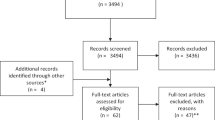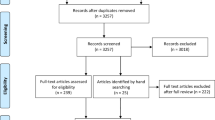Abstract
The Physical Activity Recall Assessment for People with SCI (PARA-SCI) has demonstrated the best test-retest reliability and validity of self-report measures of leisure-time physical activity (LTPA) for adults with SCI. However, the absence of internal consistency reliability data has been raised as a concern. Internal consistency is relevant only for unidimensional measures. In other populations, LTPA is known to be a multidimensional construct, evaluated with multidimensional measures. We tested for unidimensionality through secondary analysis of PARA-SCI data (n = 703). Cronbach’s α was 0.227. Principal components analysis showed two components/dimensions (‘Moderate and Heavy Intensity LTPA’ and ‘Mild Intensity LTPA’) explained 73% of the variance. Binary logic crosstabulation produced no discernible patterns of behavioural interrelatedness across LTPA intensities. Together, these data demonstrate the multidimensionality of LTPA and the PARA-SCI is not unidimensional. Internal consistency should not be a criterion for evaluating LTPA questionnaires for use in studies of people with SCI.
This is a preview of subscription content, access via your institution
Access options
Subscribe to this journal
Receive 12 print issues and online access
$259.00 per year
only $21.58 per issue
Buy this article
- Purchase on Springer Link
- Instant access to full article PDF
Prices may be subject to local taxes which are calculated during checkout
Similar content being viewed by others
References
Martin Ginis KA, van der Ploeg HP, Foster C, Lai B, McBride CB, Ng K, et al. Participation of people living with disabilities in physical activity: a global perspective. Lancet. 2021;398:443–55.
van den Berg-Emons RJ, Bussmann JB, Stam HJ. Accelerometry-based activity spectrum in persons with chronic physical conditions. Arch Phys Med Rehabil. 2010;91:1856–61.
Nightingale TE, Rouse PC, Thompson D, Bilzon JLJ. Measurement of physical activity and energy expenditure in wheelchair users: methods, considerations and future directions. Sports Med – Open. 2017;3:10.
Martin Ginis KA, Latimer AE, Craven BC, Hicks AL. Development and evaluation of an activity measure for people with spinal cord injury. Med Sci Sports Exerc. 2005;37:1099–111.
Lankhorst K, Oerbekke M, van den Berg-Emons R, Takken T, de Groot J. Instruments measuring physical activity in individuals who use a wheelchair: a systematic review of measurement properties. Arch Phys Med Rehabil. 2020;101:535–52.
Dunn TJ, Baguley T, Brunsden V. From alpha to omega: a practical solution to the pervasive problem of internal consistency estimation. Br J Psychol. 2014;105:399–412.
Sijtsma K. On the use, the misuse, and the very limited usefulness of Cronbach’s alpha. Psychometrika. 2009;74:107–20.
Pettee Gabriel KK, Morrow JR Jr, Woolsey AL. Framework for physical activity as a complex and multidimensional behavior. J Phys Act Health. 2012;9:S11–8.
Terwee CB, Mokkink LB, van Poppel MN, Chinapaw MJ, van Mechelen W, de Vet HC. Qualitative attributes and measurement properties of physical activity questionnaires: a checklist. Sports Med. 2010;40:525–37.
Martin Ginis KA, Latimer AE, Buchholz AC, Bray SR, Craven BC, Hayes KC, et al. Establishing evidence-based physical activity guidelines: methods for the study of health and activity in people with spinal cord injury (SHAPE SCI). Spinal Cord. 2008;46:216–21.
Martin Ginis KA, Latimer AE. Physical activity recall assessment for people with spinal cord injury: administration and scoring manual. University of British Columbia, Vancouver BC, Canada; 2018.
Tavakol M, Dennick R. Making sense of Cronbach’s alpha. Int J Med Educ. 2011;2:53–5.
van der Scheer JW, Martin Ginis KA, Ditor DS, Goosey-Tolfrey V, Hicks AL, West CR, et al. Effects of exercise on fitness and health of adults with spinal cord injury: a systematic review. Neurology. 2017;89:736–45.
Martin Ginis KA, van der Scheer JW, Latimer-Cheung AE, Barrow A, Bourne C, Carruthers P, et al. Evidence-based scientific exercise guidelines for adults with spinal cord injury: an update and a new guideline. Spinal Cord. 2018;56:308–21.
Martin Ginis KA, Arbour-Nicitopoulos KP, Latimer AE, Buchholz AC, Bray SR, Craven CC, et al. Leisure time physical activity in a population-based sample of people with spinal cord injury Part II: Activity types, intensities, and durations. Arch Phys Med Rehabil. 2010;91:729–33.
Au JS, Totosy De Zepetnek JO, Macdonald MJ. Modeling perceived exertion during graded arm cycling exercise in spinal cord injury. Med Sci Sports Exerc. 2017;49:1190–6.
Funding
KMG holds the Reichwald Family UBC Southern Medical Program Chair in Preventive Medicine.
Author information
Authors and Affiliations
Contributions
FL and KMG conceptualised the paper. FL designed the analysis plan, conducted the analyses and drafted sections of the manuscript. KMG drafted sections of the manuscript. Both authors edited the final version of the manuscript.
Corresponding author
Ethics declarations
Competing interests
The authors declare no competing interests.
Additional information
Publisher’s note Springer Nature remains neutral with regard to jurisdictional claims in published maps and institutional affiliations.
Supplementary information
Rights and permissions
Springer Nature or its licensor (e.g. a society or other partner) holds exclusive rights to this article under a publishing agreement with the author(s) or other rightsholder(s); author self-archiving of the accepted manuscript version of this article is solely governed by the terms of such publishing agreement and applicable law.
About this article
Cite this article
Lyons, F.L., Martin Ginis, K.A. Multidimensionality of leisure-time physical activity behaviour in adults with spinal cord injury: implications for measurement. Spinal Cord 62, 88–90 (2024). https://doi.org/10.1038/s41393-023-00947-6
Received:
Revised:
Accepted:
Published:
Issue Date:
DOI: https://doi.org/10.1038/s41393-023-00947-6



